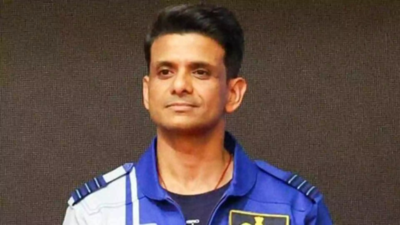The Axiom-4 mission successfully launched at 12:01 pm IST on Wednesday from NASA's Kennedy Space Center, embarking on a journey to the International Space Station (ISS).

The mission, carrying a crew including India's Shubhanshu Shukla, alongside Anne McClain, Nichole Ayers, and Peggy Whitson, is transporting the four private astronauts to low Earth orbit. Docking is slated for 4:30 pm IST on Thursday at the space-facing port of the Harmony module, marking the beginning of a two-week period dedicated to scientific research.
The voyage from launch to docking is estimated to take approximately 28.5 to 29 hours. During their two-week stay at the ISS, the crew will be engrossed in conducting scientific research and participating in outreach activities.
The mission originated from Launch Complex 39A at NASA's Kennedy Space Center in Florida, a location of historical significance as the departure point for Neil Armstrong's lunar mission. Donning specialized flight suits, the Ax-4 crew boarded the Dragon capsule "C213". Comprehensive pre-launch checks were then carried out in collaboration with SpaceX and NASA teams.
Approximately 35 minutes before liftoff, the Launch Director authorized the fuelling process, following the activation of the crew's emergency escape mechanism. The Falcon-9 rocket received its supercooled liquid oxygen and RP-1 kerosene fuel. With five minutes remaining, the Dragon capsule transitioned to internal power. The successful culmination of the countdown required absolute synchronisation across all systems.
At T-0, the nine Merlin engines of the Falcon-9 ignited, launching the spacecraft into the sky. Within a minute, the craft surpassed the speed of sound. The critical "Max Q" phase, during which the vehicle experienced maximum aerodynamic stress, occurred at 57 seconds.
As the vessel continued its ascent towards low-Earth orbit (LEO), the crew endured intensifying gravitational forces.
Roughly 150 seconds after launch, the first stage detached and initiated its return to Earth, targeting an automated landing on a platform in the Atlantic Ocean. Meanwhile, the second stage continued to propel the Dragon capsule towards its intended orbit.
Ten minutes post-launch, the Dragon capsule separated and began its independent flight. The nose cone opened, revealing vital navigation equipment. Reaching speeds exceeding 27,000 km/hr, the craft orbits Earth every 90 minutes.
The subsequent 20-24 hours involved making precise orbital adjustments. The Dragon capsule executed calculated engine burns to align its trajectory with that of the ISS. The craft depended on GPS, radar, and internal sensors for accurate positioning.
The Dragon capsule approached the ISS methodically, pausing at predetermined waypoints from a distance of 400 metres. Ground control authorized each step of the approach. At 20 metres, the craft's laser sensors and cameras guided it towards the docking port on the Harmony module.
The connection process unfolded in two stages: a magnetic soft capture followed by a mechanical hard capture, creating an airtight seal.
Following thorough pressure and leak checks, the crew entered the ISS. The Ax-4 team commenced their two-week scientific program, which included research into diabetes. For Shubhanshu Shukla, this mission marks a significant personal achievement and highlights India's growing prominence in space exploration.
Newer articles
Older articles
 Rishabh Pant's Game-Changing Innings Draw Adam Gilchrist Comparisons, Says Greg Chappell
Rishabh Pant's Game-Changing Innings Draw Adam Gilchrist Comparisons, Says Greg Chappell
 Greg Chappell: Rishabh Pant's Explosive Batting Redefining Cricket
Greg Chappell: Rishabh Pant's Explosive Batting Redefining Cricket
 Birmingham Nets Offer Clues: Bumrah's Intent and Kuldeep's Drive Ahead of Second Test
Birmingham Nets Offer Clues: Bumrah's Intent and Kuldeep's Drive Ahead of Second Test
 Gavaskar Calls for Kuldeep Yadav's Inclusion in Second Test Following India's Defeat Against England
Gavaskar Calls for Kuldeep Yadav's Inclusion in Second Test Following India's Defeat Against England
 Bollywood's "Swades" Anthem Joins Axiom-4 Mission, Fueling Indian Astronaut's Space Journey
Bollywood's "Swades" Anthem Joins Axiom-4 Mission, Fueling Indian Astronaut's Space Journey
 Stokes Lauds England's Openers for Setting Up Thrilling Chase Against India
Stokes Lauds England's Openers for Setting Up Thrilling Chase Against India
 Rogue Star Threat: Earth's Solar System Stability at Risk, New Study Warns
Rogue Star Threat: Earth's Solar System Stability at Risk, New Study Warns
 Bangladesh's Shadman Islam Defends Batting Lineup After Day 1 Setbacks Against Sri Lanka
Bangladesh's Shadman Islam Defends Batting Lineup After Day 1 Setbacks Against Sri Lanka
 Mirabai Chanu Reveals Relentless Focus on Training, Weight, and Sacrifices Required for Elite Weightlifting
Mirabai Chanu Reveals Relentless Focus on Training, Weight, and Sacrifices Required for Elite Weightlifting
 India Aims to Rewrite History in Birmingham Test After Headingley Setback
India Aims to Rewrite History in Birmingham Test After Headingley Setback